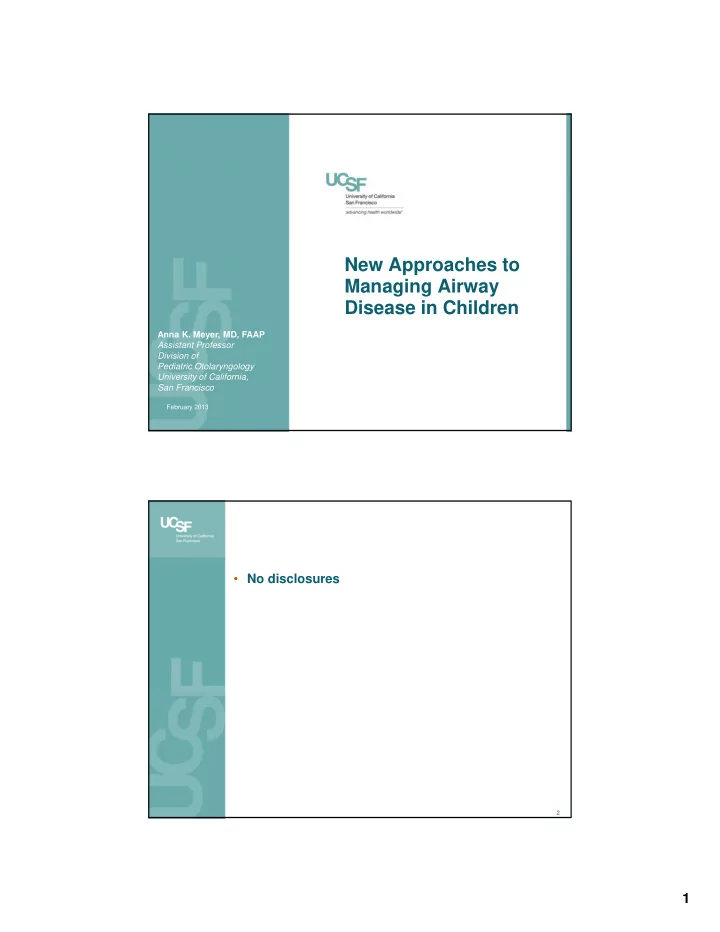

New Approaches to Managing Airway Disease in Children Anna K. Meyer, MD, FAAP Assistant Professor Division of Pediatric Otolaryngology University of California, San Francisco February 2013 • No disclosures 2 1
Overview • Laryngotracheal Stenosis • Laryngomalacia • Airway Hemangioma • Obstructive Sleep Apnea • Vocal Cord Paralysis • EXIT Procedure* *time-permitting 3 Laryngotracheal Stenosis • NICU management: Prevention – Small ETT – Uncuffed ETT – Reduced Intubation • Limitation of meconium ETT suction • Reduced oxygen delivery • CPAP* • Surfactant – Reducing infection Jatana, et al., 2010 4 2
Laryngotracheal Stenosis • Balloon dilation • Advantage over rigid or bougie dilation – Maximize radial direction – Less shearing vertical damage to airway 5 Choanal Atresia 6 3
Laryngotracheal Stenosis • Endoscopic posterior graft • Gerber, et al., 2013: 89% success 7 Laryngomalacia • All that wheezes is not asthma….. ……all noisy breathing is not laryngomalacia. 8 4
Stridor: Evaluation • SPECSR – S everity – P rogression/ Phase – E ating – C yanosis/ apneas – S leeping – R adiologic review 9 Etiologies of Stridor • Laryngeal • Supralaryngeal – Laryngomalacia – Pyriform aperture stenosis – Vocal cord paralysis – Choanal atresia – Saccular cysts – Lacrimal duct cyst – Webs – Nasopharyngeal mass – Respiratory papillomas – Facial skeletal – Subglottic hemangiomas abnormalities – Subglottic stenosis – Base of tongue mass – Laryngeal cleft – Adenotonsillar hypertrophy – Foreign body – macroglossia 10 5
Etiologies of Stridor Tracheobronchial – Tracheomalacia, bronchomalacia – Vascular anomalies – Stenosis – Foreign body – TEF – Bronchiolitis, bronchitis 11 Evaluation Flexible laryngoscopy High kilovoltage, magnified airway films Airway fluoroscopy Swallow studies Rigid endoscopy – which patients? Inconsistent with Laryngomalacia Classic Laryngomalacia Expiratory or biphasic stridor Inspiratory-only Stridor Work of breathing No work of breathing Poor weight gain Normal weight gain Abnormal AP films No OSA Supraglottoplasty Normal AP films Re-evaluation in one month Rigid endoscopy Mancuso, et al., 1996 12 6
Medical Management • Reassuring parents of favorable prognosis – Condition is usually self-limiting • Position adjustments – More prominent when supine or agitated • Reflux precautions/ medications • Frequent evaluation by pediatrician to assess: – Growth – Feeding – Breathing 13 Surgical Indications • Failure to thrive • Obstructive sleep apnea • Awake persistent apneas/ cyanosis • Pulmonary hypertension/ Cor pulmonale • Severe reflux • Recurrent aspiration • Disease not spontaneously resolve 14 7
Treatment • Approaches • Laser • Microdebrider • Cold steel • Unilateral vs. bilateral 15 Airway Hemangioma • Beta Blockers 9 weeks old Léauté-Labrèze C et al Post-4 weeks of systemic June 12, 2008 corticosteroids 16 8
10 weeks old post-7 days propranolol 17 6 months age steroids discontinued at 2 mos 18 9
9 mos age propranolol discontinued 19 Airway Hemangioma At admission 6 days post-propranolol 20 10
Airway Hemangioma • 5-10% non-responders • Traditional approaches: laser, steroids, etc. • Submucous resection Vijayasekaran, et al., 2006; O- Lee & Messner, 2008 21 Obstructive Sleep Apnea • Failure of tonsillectomy – SDB often is multifactorial – Effective in 60-70% of children with significant tonsillar hypertrophy – Only effective in 10 – 25% of complex children • Obesity • Retrognathia • Craniofacial syndromes • Neuromuscular disorders 22 11
Common Causes of Residual OSA in Children • Adenoid pad regrowth • Lingual tonsillar hypertrophy • Tongue base collapse • Occult laryngomalacia • Inferior turbinate hypertrophy 23 Sleep Endoscopy Durr, Meyer, Rosbe, 2012; Koltai, 2012 24 12
Treatments 25 Tongue Base • Tongue reduction • Suture suspension • Anterior mandibular osteotomy/genioglo ssus advancement • Mandibular distraction 26 13
Vocal cord paralysis • Acute paralysis – Tracheotomy – Vocal cord suture lateralization – Injection vocal cord augmentation • Long-term/permanent paralysis – Endoscopic posterior graft – Arytenoidectomy – Cordotomy – Thyroplasty – Reinnervation Chen & Inglis, 2011 27 Reversible lateralization • Lichtenberger, 1983 • Endo-extralaryngeal carrier instrument 28 14
Suture Lateralization 29 Pediatric Lateralization Matthur, et al., 2004 30 15
EXIT Procedure • EX utero Intrapartum Treatment • Defined by interdisciplinary approach 31 Cervical Masses 32 16
33 Congenital High Airway Obstruction Syndrome (CHAOS) 34 17
35 36 18
37 38 19
Summary • More endoscopic approaches • More technology • Earlier interventions • More complex evaluations 39 20
Recommend
More recommend